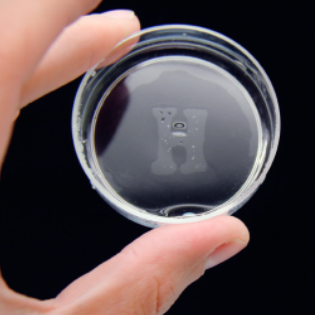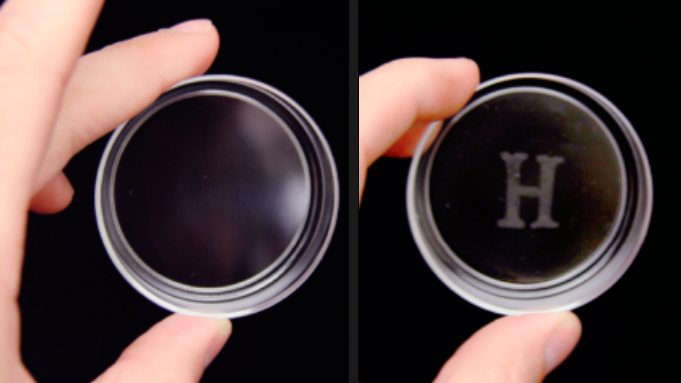Here’s a short research paper from 2013 that explains how to create “hydroglyphics”, or writing with selecting surface wetting. In it, an apparently normal-looking petri dish is treated so as to reveal a message when wetted with water vapor. The contrast between hydrophobic and hydrophilic surfaces, which is not visible to the naked eye, becomes visible when misted with water. All it took was a mask, and a little treatment with a modified Tesla coil.
 Plastics tend to be hydrophobic, meaning their surface repels water. These plastics also tend to be non-receptive to things like inks and adhesives. However, there is an industrial process called corona treatment (invented by Verner Eisby in 1951) that changes the surface energy of materials like plastics, rendering them more receptive to inks, coatings, and adhesives. Eisby’s company Vetaphone still exists today, and has a page describing the process.
Plastics tend to be hydrophobic, meaning their surface repels water. These plastics also tend to be non-receptive to things like inks and adhesives. However, there is an industrial process called corona treatment (invented by Verner Eisby in 1951) that changes the surface energy of materials like plastics, rendering them more receptive to inks, coatings, and adhesives. Eisby’s company Vetaphone still exists today, and has a page describing the process.
What’s this got to do with the petri dishes and their secret messages? The process is essentially the same. By using a Tesla coil modified with a metal wire mesh, the surface of the petri dish is exposed to the coil’s discharge, altering its surface energy and rendering it hydrophilic. By selectively blocking the discharge with a nonconductive mask made from a foam sticker, the masked area remains hydrophobic. Mist the surface with water, and the design becomes visible.
The effects of corona treatment decay over time, but we think this is exactly the sort of thing that is worth keeping in mind just in case it ever comes in useful. Compact Tesla coils are fairly easy to get a hold of nowadays, but it’s also possible to make your own.















Doesn’t beat microdots, or Tor
In one of my previous jobs we would use a plasma cutter to do the same thing, but on glass.
The end goal was to able to print silver on it without it beading up.
It worked surprisingly well, just hover the plasma gun an inch over the glass, print the liquid silver with a plotter, and cure.
What kind of plasma cutter that was? I’ve heard there is some special kind of plasma cutter torches with 2 electrodes that can be used to cut non-conductive materials. As opposed to regular steel cutting one, which does use the workpiece as one of the electrodes. Is that needed to treat glass?
This goes back at least ten years, but as far as I remember was just a regular plasma cutter, just not used as it was meant to be.
There is a surprising number of research papers about applying masking tape to something, then applying a surface treatment or deposition, then observing how the treatment didn’t effect the surfaces under the tape
*affect
Nice. Did they come up with a clever name for this magical process? I don’t know, something like, maybe, “masking”?
Surface activation like this is also the key to gluing “difficult” plastics like HDPE and PTFE.
“However, there is an industrial process called corona treatment (invented by Verner Eisby in 1951) that changes the surface energy of materials like plastics, rendering them more receptive to inks, coatings, and adhesives.”
yeah. blind in one eye. can’t see out the other, apparently.
You can just use a gas torch, moved fast. Works great. Or, of course, you can also just buy a marker designed to write nicely on plastic, the BIC Intensity Metal Pro for instance, rather than yet another Sharpie.
I once did a deep dive into the historical scientific literature of this. The original term was “breath figures”, where you could play a flame over a piece of glass, and the result was one piece divided into two sections where you could breathe over it and one side would fog up and the other wouldn’t.
The original literature had some interesting observations. You can activate the surface of a piece of glass, then place a 2nd piece on top of the first for a few minutes, and the activation will transfer to the 2nd piece of glass!
The literature had all sorts of conjectures as to how this was happening (slight contamination from the flame), sparking lots of experiments using (for example) hydrogen flames that used no carbon. Eventually someone reproduced it using electric discharge, so they then knew the effect wasn’t due to contamination.
I still don’t know what the actual mechanism is. “Surface energy” isn’t a very visual explanation.
Dan Gelbart points out that when you sandblast metal it activates the surface and causes paint to stick, but if you don’t paint within 24-48 hours the activation goes away and paint won’t stick as well.
https://www.youtube.com/watch?v=x7onZGqrYyY
similar to secretly writing on a mirror or window with your finger – the oil deposition makes the message reveal when things steam up
The paper says it’s the oxygen in the air that is activated and then inserts hydrophilic groups into the surface of the polystyrene. So in other words the ozone breaks and binds.
So now the question is what does a flame’s plasma do to the air in your example.
I have a feeling that glass is harder to chemically affect than polystyrene anyway.
And once again a reply to someone else (PWalsh in this case) ends up in the wrong place.
Oh well, it’s HaD, I’ll be probably censored away anyhow after a short while :)